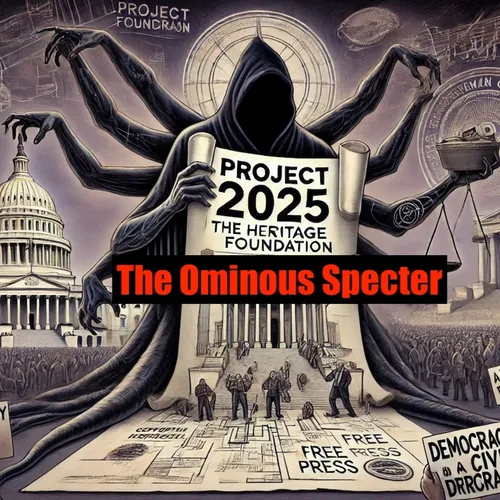"Unmasking Project 2025: The Heritage Foundation's Roadmap for Reshaping American Governance"
- Author
- Quiet.Please
- Published
- Thu 27 Feb 2025
- Episode Link
- https://www.spreaker.com/episode/unmasking-project-2025-the-heritage-foundation-s-roadmap-for-reshaping-american-governance--64611768
As I delved into the intricacies of Project 2025, a initiative spearheaded by the Heritage Foundation, I found myself navigating a complex web of policy proposals and ideological ambitions that promise to reshape the very fabric of American governance. This 900-plus page blueprint, often referred to as the “Mandate for Leadership,” is more than just a collection of policy ideas; it is a comprehensive roadmap for a future Republican administration, particularly one led by Donald Trump, to implement sweeping changes across various sectors of federal government.
One of the most striking aspects of Project 2025 is its vision for the executive branch. The project advocates for a significant consolidation of power in the White House, aligning with the unitary executive theory that aims to centralize control over government agencies. This includes plans to eliminate the independence of key agencies such as the Department of Justice (DOJ), the Federal Communications Commission (FCC), and the Federal Trade Commission (FTC)[3].
For instance, Project 2025 suggests that all Department of State employees in leadership roles should be dismissed and replaced with individuals more loyal to a conservative president. Kiron Skinner, who wrote the State Department chapter of the project, has expressed her belief that most State Department employees are too left-wing and need to be replaced. This approach is part of a broader strategy to ensure that federal employees answer directly to the president, a move that critics argue would undermine the checks and balances inherent in the U.S. system of government[3].
The project's impact on federal agencies extends to areas such as disaster response and emergency management. Project 2025 proposes reforming the Federal Emergency Management Agency (FEMA) by shifting the majority of preparedness and response costs from the federal government to states and localities. This recommendation is based on the argument that FEMA is "overtasked, overcompensates for the lack of state and local preparedness and response, and is regularly in deep debt"[1].
President Trump's recent actions reflect this alignment, as he established a review council to advise on FEMA's capabilities and suggested that states should take more responsibility for disaster response. "That's what states are for, to take care of problems," Trump said, echoing the project's call for a more localized approach to disaster management[1].
In the realm of public education, Project 2025 outlines a radical overhaul that would gut federal funding and dismantle critical programs. The proposal includes plans to deny vulnerable students the resources they need to succeed and to sanction discrimination against LGBTQ+ students. The National Education Association (NEA) has vehemently opposed these plans, highlighting that they would be disastrous for the nation's education system[4].
The economic implications of Project 2025 are equally profound. The initiative proposes eliminating key public transportation projects, such as the Capital Investment Grants (CIG) program, which has been instrumental in funding transformative infrastructure projects across the U.S. This move could significantly hinder the mobility of Americans without cars, making it harder for them to get to work or travel within their communities[2].
Additionally, Project 2025 targets social safety nets and labor protections. It recommends cutting overtime protections for millions of workers, limiting access to food assistance for over 40 million people, and restricting safety nets for farmers to only "unusual situations," despite the common and unpredictable challenges farmers face[2].
The project also seeks to roll back civil rights protections, including diversity, equity, and inclusion (DEI) programs and LGBTQ+ rights in healthcare, education, and workplaces. Gene Hamilton, a former Trump DOJ...
